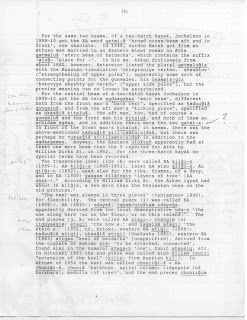 |
| Plans of the Adirondack guide boat from the Mystic Seaport Museum which sells them for $75. |
 |
| Lines of the Adirondack Guide Boat from the Mystic Seaport Museum |
Guideboats are bottom-board boats with natural knees used as frames: the dory-building technique taken to the extreme. Builders developed a smooth-skin lap strake construction method now known as the guideboat lap. The small boats-like the 13' Parsons boat at 57 pounds and the 13' 6" Blanchard boat at 53 pounds-were best suited to be carried in to fish small ponds, for which they were called "raiders." The 16' guideboats are considered the best compromise between speed and carrying capacity, working well solo or carrying a guide and sport with their load of camping gear. The 16' GHOST weighs just 64 pounds, while the 15' 7" Cole boat weighs 59. The plans drawn by Dave Dillion do not require lofting; full dimensions are provided for each frame. Hallie Bond's Boats and Boating in the Adirondacks provides more historical information. Today, guideboats are successfully built as frameless strip-planked boats and as semi-strip-planked boats with glued joints over laminated frames. From 87 Boat Designs by Ben Fuller. Boat is owned by the Adirondack Museum(64.170.1), Blue Mountain Lake, New York. Plans drawn in 1984.
So the other day, a friend of mine called me to see if I wanted to see his new/old guideboat that he had bought on craigslist for about $1k. The boat was an original built about 100 years ago. The boat was still mostly intact. There was one hole in it that had been patched and most of the planking was still sound except for a few places where the planks had opened up.
Ribs/frames were in two halves with their bottoms overlapping and nailed together as well as screwed to the floor plank. Each rib was sawn from natural crooks, that is wood whose grain roughly followed the curve of the rib. A number of ribs near the center of the boat had the same shape. Toward the ends of the boat, the ribs gradually became narrower. Builders appear not to have had lines for these boats. Instead, each builder had templates for their ribs. None of those seem to have survived. The lines shown in the drawings above were taken off boats that have made it into museums.
The planking edges were beveled and lapped with the laps clinch nailed to each other.
As I understand the process, the ribs were first attached to the bottom plank and then the planks were screwed to the ribs.
The guide boats had a relatively short life span. Apparently, they were designed specifically for the guide trade in which the guide needed a boat big enough for two people but light enough to carry between lakes lacking road access. As soon as roads were built to the lakes and resorts built on their shores, the need for the guides went away and with them their boats.
Finally, I would like to share some unease I had with this boat when I was first exposed to it. My unease stemmed from the fact that this boat required an industrial economy to build. Not only did you need a professional boat builder with a band saw but you also needed thin planks and lots of small screws and nails, none of which you could readily scrounge from your immediate environment. The guide boat clearly did not meet the post-apocalyptic stamp of approval, that is, it would be impractical or even impossible in a world that lacked a sophisticated industrial economy to supply all its component parts and tools to manufacture them.







































